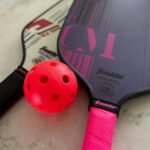Introduction to Youth Lacrosse Sticks
Youth lacrosse sticks are essential tools in the sport of lacrosse, as they significantly influence player performance and safety. These specialized sticks are designed to cater to the needs of younger athletes, offering a lighter frame and specific dimensions to accommodate their developing physical abilities. Unlike adult lacrosse sticks, which are often larger and heavier, youth sticks provide the necessary control and maneuverability that young players require to develop their skills effectively.
The primary components of a lacrosse stick include the shaft and the head. The shaft serves as the primary handle, and it is critical for players to select a shaft that is appropriate for their height and strength. In contrast, the head of the stick is responsible for catching and throwing the ball. Its design can vary based on the different positions played on the field, emphasizing the importance of choosing the right stick based on each player’s specific role. For instance, attack players may prefer a stick with a wider head for superior ball control, while defenders might opt for a head that allows for better poke checks.
Proper sizing of youth lacrosse sticks is crucial for several reasons. A stick that is too long or too short can hinder a player’s ability to handle the ball and execute shots accurately, which directly affects their performance on the field. Furthermore, using a stick that does not fit well can lead to discomfort and increase the risk of injury. As young athletes grow and develop, it is important to frequently reassess their equipment to ensure optimal fit and functionality. With the right youth lacrosse stick, players can enhance their skills, boost their confidence, and enjoy a safer playing experience.
Why Proper Sizing Matters
Proper sizing of youth lacrosse sticks plays a crucial role in a player’s development and performance on the field. When a lacrosse stick is correctly sized for a young athlete, it enhances their ability to control the stick and execute fundamental skills. A well-fitted stick allows for better handling, passing, and shooting, enabling young players to develop essential techniques that are foundational to mastering the game.
One significant aspect of proper sizing is its impact on the overall skill development of youth players. When a stick is too long or too short, it can hinder a player’s ability to practice effectively, leading to frustration and potential disengagement from the sport. Young athletes might struggle to perform basic maneuvers, which can stifle their growth and understanding of the game’s dynamics. By ensuring that a lacrosse stick is the appropriate length, players are more likely to remain engaged and improve their skill set over time.
Moreover, proper stick sizing also has implications for injury prevention. A stick that does not fit a player correctly can lead to poor mechanics during gameplay. These improper mechanics may increase the risk of overuse injuries or acute injuries due to awkward movements. Young players are particularly susceptible to these issues as their bodies are still developing; hence, a correctly sized stick can help mitigate these risks and promote safe play.
Additionally, the long-term impact of using a properly sized lacrosse stick cannot be underestimated. Players who learn to play with equipment tailored to their size are more likely to develop sound techniques and habits that will serve them throughout their lacrosse careers. This foundational understanding is vital for those aspiring to excel in the sport, as bad practices established early on can be challenging to alter later in their athletic journey.
Understanding Stick Length
The length of a lacrosse stick is a critical factor that influences a player’s performance on the field. In youth lacrosse, stick length is generally measured from the tip of the head to the end of the handle. The available lengths for youth sticks typically range from 36 inches to 42 inches, with variations depending on player age and position. Correct measurement is essential, as an improperly sized stick can impede a player’s ability to control the ball and make accurate passes.
To determine an appropriate stick length, players should consider their height, age, and position on the field. For instance, younger players or those who are shorter may benefit from a shorter stick to improve maneuverability and control. Conversely, taller players may find greater advantage in using a longer stick that can enhance their reach, thereby assisting in defensive plays and ball retrieval. A player’s position also influences their choice; for example, attackmen often prefer shorter sticks for better dexterity while midfielders may opt for a slightly longer length for reach and leverage during play.
In youth lacrosse, manufacturers provide guidelines based on age; however, these recommendations merely serve as a starting point. Players and coaches should assess personal preferences and adjust stick lengths accordingly to create a more individualized approach to stick selection. Using a stick that is the correct length not only enhances performance but also helps to prevent injuries commonly associated with improper gear, such as strain or awkward body positioning when handling the ball. Ultimately, investing time in finding the right stick length can significantly impact a player’s development and enjoyment of the game.
Choosing the Right Stick Weight
When selecting a youth lacrosse stick, the weight of the stick plays a crucial role in overall performance and player experience. A lighter stick typically offers a significant advantage, particularly for younger players who are still developing their skills and strength. Lighter sticks enable quicker stick handling and increased shot speed, allowing for greater agility on the field. This can enhance a player’s ability to perform dodges, passes, and shots with precision.
Conversely, a heavier stick may provide a player with more stability and control, particularly in defensive positions where strength and durability are essential. Heavier sticks can contribute to a powerful shot and robust checks, making them suitable for players who wish to establish a commanding presence during gameplay. It’s important for players to consider their unique style of play. For instance, offensive players may prefer a lightweight stick for enhanced maneuverability, whereas defensive players may benefit from the added weight of a sturdier stick.
Several factors influence a player’s preference regarding stick weight. These include their age, physical development, and specific position on the field. Younger players, especially those who are still growing, might want to opt for a lighter stick to ensure they can handle it comfortably without experiencing fatigue. Moreover, as players advance in skill and physicality, they may gravitate towards heavier sticks as their strength increases. Ultimately, the best approach is to allow players to experiment with different weights in practice settings, enabling them to find a stick that feels just right.
Choosing the right stick weight is fundamental to optimizing a player’s performance and enjoyment of the game. It is advisable to test various models and brands to determine which weight best suits individual preferences, providing a solid foundation for skill development and competitive play.
Evaluating Stick Width and Pocket Depth
When it comes to youth lacrosse stick sizing, one of the critical aspects that often goes overlooked is the width of the stick’s head. The width plays a significant role in how effectively players can handle the ball and execute precise passes. A wider stick head can enhance ball retention and control, particularly for younger players who are still developing their skills. Conversely, a narrower head may offer better throwing accuracy and speed, enabling players to make faster passes. A careful evaluation of head width can contribute to a player’s overall performance, particularly when considering their individual style of play.
In addition to head width, pocket depth is another essential factor that influences ball control. A deeper pocket allows for increased ball hold, which can be beneficial during gameplay, particularly for beginners who may struggle with catching and maintaining possession. However, a deep pocket can also slow down the release time during passing, which may not benefit all players. Some youth players might prefer a shallower pocket for quicker ball release and improved throwing speed, enhancing their ability to execute fast-paced plays. It is therefore vital for young athletes to assess their needs and preferences when determining the depth of their stick’s pocket.
Determining the optimal stick width and pocket depth generally requires a balance of personal preference and playing style. For players just starting out, experimenting with different configurations can be particularly helpful. Coaches and experienced players can provide insight, helping to guide youth athletes in making informed decisions about their equipment. By assessing both the stick’s width and pocket depth, players can customize their sticks to achieve better ball control and throwing precision, which are essential skills in the sport of lacrosse.
Considering Player Skill Level
When choosing a youth lacrosse stick, understanding the player’s skill level is essential in determining the appropriate size and type of stick. The skill levels are generally categorized into three distinct groups: beginner, intermediate, and advanced players. Each category has specific needs and preferences that influence the selection of the stick.
Beginner players, often new to the sport, benefit from a stick that offers an easier grip and greater control. A shorter stick can enhance their ability to handle the ball, as it allows for better maneuverability and promotes confidence in their developing skills. The focus for beginners should be on a stick that is lightweight, reducing fatigue during play, while still being sturdy enough to withstand initial learning experiences. A generally accepted recommendation for beginners is to choose a stick that falls within the range of 36 to 40 inches in length, accommodating their physical stature and enabling effective practice.
Intermediate players possess a greater understanding of the game and often require a stick that can accommodate their evolving skill set. At this level, it’s essential to strike a balance between control and power in shooting. Sticks in the 40 to 42-inch range allow players to enhance their long-range shots while still providing sufficient handling abilities. Additionally, advanced features such as improved pocket depth and stringing techniques can be introduced in this category, allowing players to customize their sticks according to their personal preferences.
For advanced players, who demonstrate a high level of proficiency in the sport, selecting a stick that complements their specific playing style is crucial. They often prefer longer sticks, typically between 42 and 52 inches, as these provide enhanced reach and leverage during play, permitting powerful shots and intricate stick handling. Advanced lacrosse players may also gravitate towards sticks with specialized materials for durability and performance, further refining their technique and strategies on the field.
Trial and Error: Finding the Perfect Fit
The journey to finding the ideal youth lacrosse stick can often be a process of trial and error, as each player’s preferences and physical attributes vary significantly. Young players should begin by experimenting with different stick types and sizes to discover which one feels most comfortable and allows for optimal performance. It is essential to note that a stick that works well for one player might not suit another, making this exploration critical.
When trying various sticks, players should pay close attention to key factors such as weight, balance, and overall length. A stick that is too heavy could hinder a player’s ability to maneuver quickly, while one that is too light may not provide the necessary strength during play. Additionally, the stick’s length should align with the player’s height, ensuring proper control and handling during games. It is advisable to consider the recommended guidelines provided by manufacturers as a starting point before further personal assessment.
Furthermore, players should practice with different sticks during training sessions, where they can assess comfort levels and adjust their performance as needed. This practice should include passing, shooting, and cradling the ball, allowing young athletes to gain a comprehensive understanding of each stick’s capabilities and limitations. By incorporating drills that involve various styles of play, players can identify which sticks enhance their skills rather than restrict them.
Ultimately, the combination of assessment, practice, and feedback from coaches or experienced players will lead to an informed decision. While it might take time and effort to determine the best fit, young athletes who embrace this trial-and-error process are more likely to make a long-term choice that aligns with their playing style, enhancing their enjoyment of the game.
Common Sizing Mistakes to Avoid
When selecting a youth lacrosse stick, various common sizing mistakes can hinder player performance and enjoyment. One prevalent error parents and players make is choosing a stick based simply on its popularity or the aesthetic appeal of its design. While brand reputation and visual elements can certainly be enticing, they should not be the primary determiners of a stick’s suitability. Each player has unique physical dimensions and playing styles that should guide the selection process.
Another frequent misconception is assuming that a longer stick equates to better performance. In reality, a youth lacrosse stick should be appropriately sized to the player’s height and skill level. A stick that is too long can hinder control and accuracy, while one that is too short may not provide the necessary reach for effective play. It is essential to prioritize comfort and maneuverability over trends or a desire to emulate professional players.
Furthermore, neglecting to account for the player’s position is another critical mistake to avoid. Different positions in lacrosse may have distinct requirements for stick length and type. For instance, attack players often prefer shorter sticks for improved control, while defense players may opt for longer sticks for added reach and checks. Understanding the nuances of these positions can significantly influence the choice of the appropriate stick.
Finally, overlooking the importance of grip and materials can lead to challenges on the field. A stick should not only fit physically but also feel comfortable in a player’s hands. Materials can impact weight, balance, and durability. Taking the time to evaluate the specifics of a youth lacrosse stick is vital for fostering a positive and productive experience on the field. By avoiding these common pitfalls, players can enhance their lacrosse journey and maximize their potential.
Conclusion and Final Thoughts
In summary, selecting the appropriate size for youth lacrosse sticks is crucial for the enjoyment and development of young players. Properly sized sticks can significantly enhance a player’s performance on the field, ensuring that they can handle the equipment effectively while developing essential skills. When choosing a lacrosse stick, factors such as the player’s age, height, and skill level must be taken into consideration. These elements come together to dictate the optimal stick length, head size, and overall weight.
Parents and coaches should prioritize a proper fit for young athletes to promote comfort and confidence during play. A stick that is too long or too heavy can hinder a player’s ability to maneuver and develop their technique, potentially discouraging their participation in the sport. Conversely, a well-fitted lacrosse stick can empower youth players to thrive, allowing them to practice with greater efficiency and engage more fully in team dynamics.
In addition, it is vital for young players to understand the significance of equipment in their game. Investing time in selecting the correct youth lacrosse sticks can lead to a more enjoyable playing experience, fostering a love for the game that potentially lasts a lifetime. Encouraging players to explore different stick options that adhere to their specific needs can also empower them to make informed decisions as they grow. Keeping in mind that preferences may shift over time, it is advisable to reassess equipment needs periodically as the child ages and develops. By prioritizing proper sizing and fit, we not only support the immediate needs of youth players but also contribute to their longer-term growth within the sport of lacrosse.






